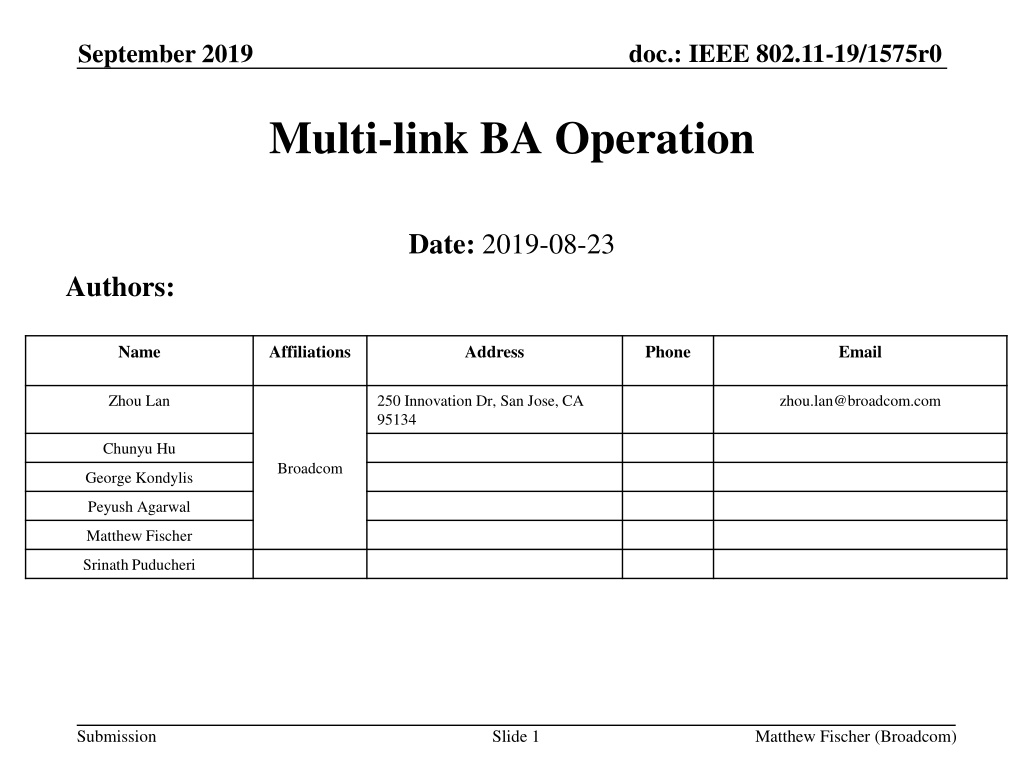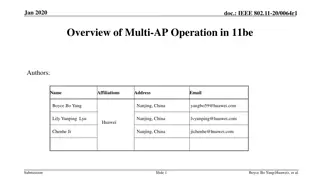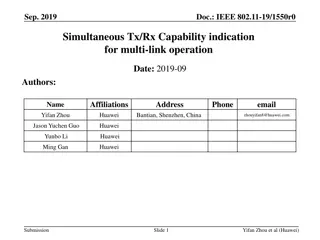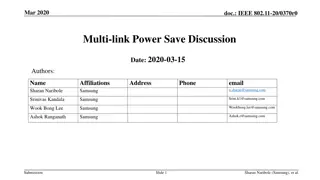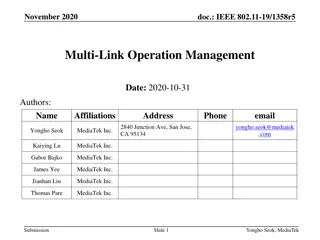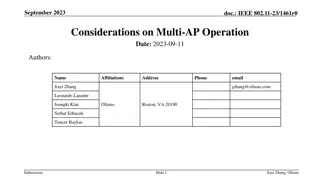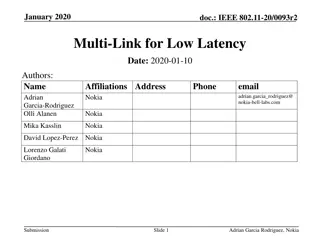IEEE 802.11-19/1575r0 Multi-Link BA Operation Overview
Presentation slides from September 2019 discussing the Multi-Link Operation (MLO) in IEEE 802.11-19/1575r0 standard. The slides cover topics such as the benefits of MLO, synchronized/asynchronized rules, terminology, architecture, and common BA sessions. The proposal aims to define an architecture supporting MLO benefits and implementation choices, including packet flow splitting and merging. Details on low and high MAC MLLE link splits are included, outlining the process of packet flow handling across multiple links.
Download Presentation

Please find below an Image/Link to download the presentation.
The content on the website is provided AS IS for your information and personal use only. It may not be sold, licensed, or shared on other websites without obtaining consent from the author. Download presentation by click this link. If you encounter any issues during the download, it is possible that the publisher has removed the file from their server.
E N D
Presentation Transcript
doc.: IEEE 802.11-19/1575r0 September 2019 Multi-link BA Operation Date: 2019-08-23 Authors: Name Affiliations Address Phone Email Zhou Lan 250 Innovation Dr, San Jose, CA 95134 zhou.lan@broadcom.com Chunyu Hu Broadcom George Kondylis Peyush Agarwal Matthew Fischer Srinath Puducheri Submission Slide 1 Matthew Fischer (Broadcom)
doc.: IEEE 802.11-19/1575r0 September 2019 Recap of the Current Discussions Multi-Link Operation (MLO) has been discussed as a major 11be feature for throughput improvement and latency reduction [1, 2] discusses the synchronized and asynchronized MLO rules [3, 4] discusses the terminology and architecture [4] discusses the multi link aggregation Packet switch, TID mapping, common BA session etc. This presentation discusses MLO operation that supports the flexibility of accommodating different implementation architectures Submission Slide 2 Matthew Fischer (Broadcom)
doc.: IEEE 802.11-19/1575r0 September 2019 Common BA Session? Assuming that a single TID between two MLO STAs is split across >1 link How many BA sessions are negotiated? MLO Device MAC Addr (M1) MAC-SAP-a MLO Entity STA (MAC/PHY) x STA (MAC/PHY) y WM WM Submission Slide 3 Matthew Fischer (Broadcom)
doc.: IEEE 802.11-19/1575r0 September 2019 Proposal Define an architecture that supports the benefits of the MLO operation while accommodating different implementation choices TX: Packet flow is split between links somewhere between the MAC SAP and the WM RX: Packet flow from different links is merged somewhere between the antenna and the MAC SAP Desire a protocol that allows packet flow split location to be an implementation choice Submission Slide 4 Matthew Fischer (Broadcom)
doc.: IEEE 802.11-19/1575r0 September 2019 Low MAC MLLE Link Split TX RX MAC SAP MAC SAP ADDR_A ADDR_X RX AMSDU DEFRAG DEAGG REORDER MACSEQ AMPDU FRAG BACON BACON ADDR_B EDCA0 EDCA1 ADDR_C ADDR_Y EDCA0 EDCA1 ADDR_Z PHY0 PHY1 PHY0 PHY1 Low split Submission Slide 5 Matthew Fischer (Broadcom)
doc.: IEEE 802.11-19/1575r0 September 2019 High MAC MLLE Link Split TX RX MAC SAP MACSEQ MAC SAP ADDR_A ADDR_X RX DEFRAG DEAGG REORDER AMSDU AMSDU AMPDU FRAG BACON AMPDU FRAG BACON RX FIFO RX FIFO BACON BACON ADDR_B EDCA0 EDCA1 ADDR_C ADDR_Y EDCA0 EDCA1 ADDR_Z PHY0 PHY1 PHY0 PHY1 High split Submission Slide 6 Matthew Fischer (Broadcom)
doc.: IEEE 802.11-19/1575r0 September 2019 High MAC split Requires some sequencing information If the split is above the MPDU, then the sequencing information needs to be generated on the TX side above the MPDU generation and carried up to the merge point on the RX side E.g. sequence value associated with MSDUs Maintain existing BA for MPDU sequencing Separate queue management Single BA or Multiple per-link BA Single BA might impose minor restrictions Submission Slide 7 Matthew Fischer (Broadcom)
doc.: IEEE 802.11-19/1575r0 September 2019 Low MAC split Requires TX queue sharing Requires RX queue sharing Or merge above the RX queue, i.e. asymmetric split between TX and RX Single BA Assuming BA Control above the split Submission Slide 8 Matthew Fischer (Broadcom)
doc.: IEEE 802.11-19/1575r0 September 2019 High vs Low The pros and cons of each split point can be debated But such a debate is best left as an implementation decision TGbe protocol definition should support a range of options Let the market select the winning implementation choice Submission Slide 9 Matthew Fischer (Broadcom)
doc.: IEEE 802.11-19/1575r0 September 2019 High MAC Split Requirement The main requirement of the high MAC split is sequencing information available at the high end of the MAC E.g. per MSDU sequencing information MSDU sequencing information can be: In addition to MPDU sequencing Tightly coupled to MPDU sequencing Submission Slide 10 Matthew Fischer (Broadcom)
doc.: IEEE 802.11-19/1575r0 September 2019 Separate MSDU Sequencing Each MSDU could contain its own MSDU sequencing numbering GSN = Global Sequence Number Only needed by high MAC devices Could be negotiated to be used, only on links that need it Can be zero-overhead See next slides Submission Slide 11 Matthew Fischer (Broadcom)
doc.: IEEE 802.11-19/1575r0 September 2019 Zero Overhead GSN SNAP Use LLC/SNAP headers to pass the global MSDU sequence number LLC/SNAP protocol (802.2) is used to encapsulate all MSDUs when forming an 802.11 frame The SNAP/DSAP and SNAP/SSAP fields are set to 0xAA to create a SNAP header and this value is not changed while the frame is inside of the 802.11 domain Proposal: At the TX side, replace SNAP/DSAP and SNAP/SSAP field values 0xAAAA with the GSN when creating the 802.11 frame from the MSDU and replace the GSN with 0xAAAA when leaving the 802.11 domain (i.e. top of the MLLE at the RX side) 802.11 MAC Header LLC/SNAP Header PHY Preamble Payload FCS SNAP/DSAP 0xAA SNAP/SSAP 0xAA Control 0x03 OUI Protocol ID 0x0800 0x000000 Submission Slide 12 Matthew Fischer (Broadcom)
doc.: IEEE 802.11-19/1575r0 September 2019 Zero Overhead GSN MACSEQ GSN uses existing SEQCON Field i.e. SEQCON of MAC header Nearly transparent vs architectural choices FRAG (4) SEQ (12) Existing SEQ Con field definition: Submission Slide 13 Matthew Fischer (Broadcom)
doc.: IEEE 802.11-19/1575r0 September 2019 GSN MACSEQ Field Size Do we need to repartition the SEQ Control field? Existing MAC SEQCON Sequence field is 12 bits New BA limit of 1024 (10 bits) Only half of SEQ space is usable to avoid ambiguity > vs < Existing field permits AMSDU aggregation average of 2 MSDU I.e. MPDU count remains the same if BA limit is increased to 2048 Desire higher average AMSDU aggregation SEQ 14 bits = BA x 1024 (10 bits), AMSDU x 8 (4 bits) FRAG 2 bits (Level 3 MAX) Increase BA Window max to 8192 (8192 MSDU => 1024 MPDU) New DATA Subtype Submission Slide 14 Matthew Fischer (Broadcom)
doc.: IEEE 802.11-19/1575r0 September 2019 GSN BAR Do we need a BA function for the GSN? In the case of a TX queued MSDU that has a timeout or for some other reason is deleted from the TX queue, the RX side needs to move past the GSN hole In MACSEQ case, this is done by sending a BAR Need something similar for GSN If single BA, then no need for GSN BA action, use regular BAR BAR and BA must be transmitted on the link associated with the frames of reference If multiple BA, then need to define at least GSN BAR GSN ADDBA, GSN DELBA optional Submission Slide 15 Matthew Fischer (Broadcom)
doc.: IEEE 802.11-19/1575r0 September 2019 Negotiate use of GSN If GSN is embedded in MSDU E.g. GSN in SNAP GSN use is negotiated If GSN is embedded in MACSEQCON No GSN negotiation needed Submission Slide 16 Matthew Fischer (Broadcom)
doc.: IEEE 802.11-19/1575r0 September 2019 RA TA Values and BA Sessions RSNA using MAC SAP addresses Generally agreed, not formally agreed Beacons using LMAC addresses? Or all Beacons using common TA, but indicating other MAC addresses within elements in the Beacon? Data MPDUs use which addresses? How many BA sessions? Submission Slide 17 Matthew Fischer (Broadcom)
doc.: IEEE 802.11-19/1575r0 September 2019 Option 1: 1 Address Use MAC SAP address for everything No need for other addresses Loss of explicit link differentiate within MPDU Single BA across links Multiple BA session is difficult What about non-MLLE STA? E.g. non-MLLE 11be and 11ax STA Scanning Non-MLLE device sees same BSS in Beacons on multiple link channels Confusing at best Submission Slide 18 Matthew Fischer (Broadcom)
doc.: IEEE 802.11-19/1575r0 September 2019 Option 2: Multiple Addresses Use WM Addresses for everything ON THE AIR Use MAC SAP address for RSNA only: Perform address substitution for encrypt/decrypt if MLLE device No substitution if non-MLLE device BA per link Submission Slide 19 Matthew Fischer (Broadcom)
doc.: IEEE 802.11-19/1575r0 September 2019 Option 3: Mixed Addresses Use MAC SAP address for MLLE devices Use WM Addresses for non-MLLE devices And Beacons, Probe Responses, etc Loss of explicit link differentiate within MPDU One BA negotiated per device connection Submission Slide 20 Matthew Fischer (Broadcom)
doc.: IEEE 802.11-19/1575r0 September 2019 Straw poll 1 Do you support that BAR and BA shall be transmitted on the link associated with the frames of reference? YES NO ABS Submission Slide 21 Matthew Fischer (Broadcom)
doc.: IEEE 802.11-19/1575r0 September 2019 Straw poll 2 Do you support that A new DATA Subtype is defined with SEQCON redefined as 2 bits of FRAG and 14 bits of SEQ? YES NO ABS Submission Slide 22 Matthew Fischer (Broadcom)
doc.: IEEE 802.11-19/1575r0 September 2019 Straw poll 3 Do you support that A BAR may be aggregated within an AMPDU that includes DATA Subtypes? YES NO ABS Submission Slide 23 Matthew Fischer (Broadcom)
doc.: IEEE 802.11-19/1575r0 September 2019 Straw poll 4 Do you support that There is a negotiation of whether there is one BA session per link or one BA session, per TID per MLLE pair? YES NO ABS Submission Slide 24 Matthew Fischer (Broadcom)
doc.: IEEE 802.11-19/1575r0 September 2019 Reference 1. https://mentor.ieee.org/802.11/dcn/19/11-19-1116-00-00be-channel-access-in- multi-band-operation.pptx 2. https://mentor.ieee.org/802.11/dcn/19/11-19-0821-02-00be-multiple-band- discussion.pptx 3. https://mentor.ieee.org/802.11/dcn/19/11-19-0773-02-00be-multi-link-operation- framework.pptx 4. https://mentor.ieee.org/802.11/dcn/19/11-19-1082-00-00be-multi-link-operation- dynamic-tid-transfer.pptx Submission Slide 25 Matthew Fischer (Broadcom)
